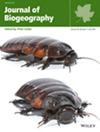Circular genetic structure of the Abies nephrolepis species complex shaped by the circular landform of Northeast Asia
Abstract
Aim
Pinaceae have been noted for their tendency towards reticulation as a result of interspecific hybridization. Here, we demonstrated the phylogeographic dynamics of the native Northeast Asian sub-alpine conifer, Abies nephrolepis species complex (ANSC), evolving in circular overlaps along the Northeast Asian landform, which functions as a corridor with the sea, thus acting as a geographic barrier.
Location
Northeast Asia: the Korean Peninsula, Japanese Archipelago, Russian Far East and northeastern China.
Taxon
Abies nephrolepis species complex (Family Pinaceae, Genus Abies, Section Balsamea, Abies nephrolepis, A. koreana, A. veitchii and A. sachalinensis).
Methods
A total of 728 individuals from 38 ANSC populations were analysed using multiplexed inter-simple sequence repeat genotyping by sequencing to capture variations in biparental nuclear genomes. Eight mitochondrial regions and eight chloroplast regions of each individual were sequenced using the MiSeq platform and Sanger sequencing. Species distribution models were generated.
Results
Bayesian clustering with 507 nuclear single nucleotide polymorphisms and the discrepancy between cytoplasmic and nuclear genome lineages implied contemporary and ancient connections between neighbouring species in the form of circular overlap. This genetic connectivity was supported by principal component analysis. Strong correlations between genetic distance and geographic distance were observed, suggesting that gene flow occurs through a continuous chain around the sea. We also found that gene flow direction and intensity changed over time, with support from palaeodistribution modelling.
Conclusion
Past hybridization events were captured in cytoplasmic genomes, generating heterogeneity across maternal ancestries. This intensive phylogeographic study demonstrates speciation with incomplete reproductive isolation (continuous gene flow) among neighbouring species with an alteration of the direction and intensity of gene flow due to climate change. The divergence of ANSC due to repeated isolation and reconnection caused by heterogenous physiological environments and climate fluctuation provides a model to solve evolutionary scenarios for reticulate evolution in Pinaceae and other plants.

 求助内容:
求助内容: 应助结果提醒方式:
应助结果提醒方式:


